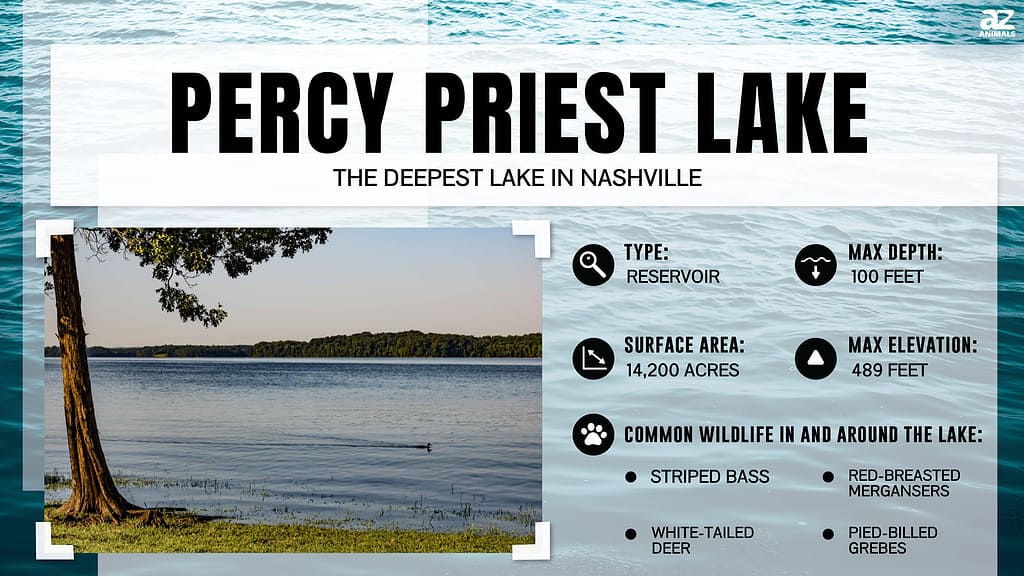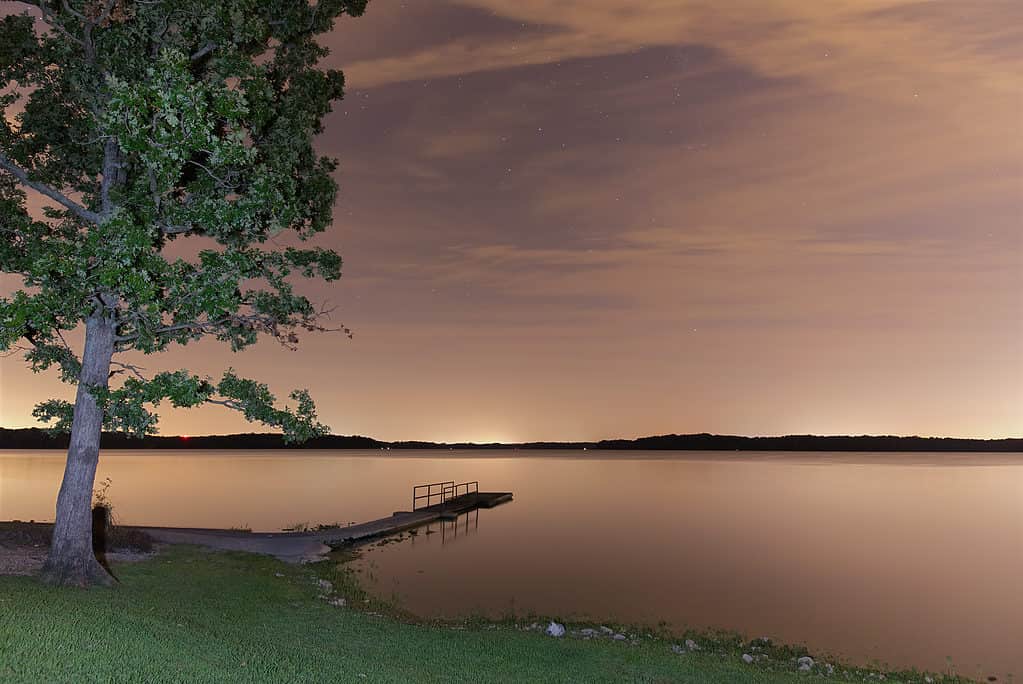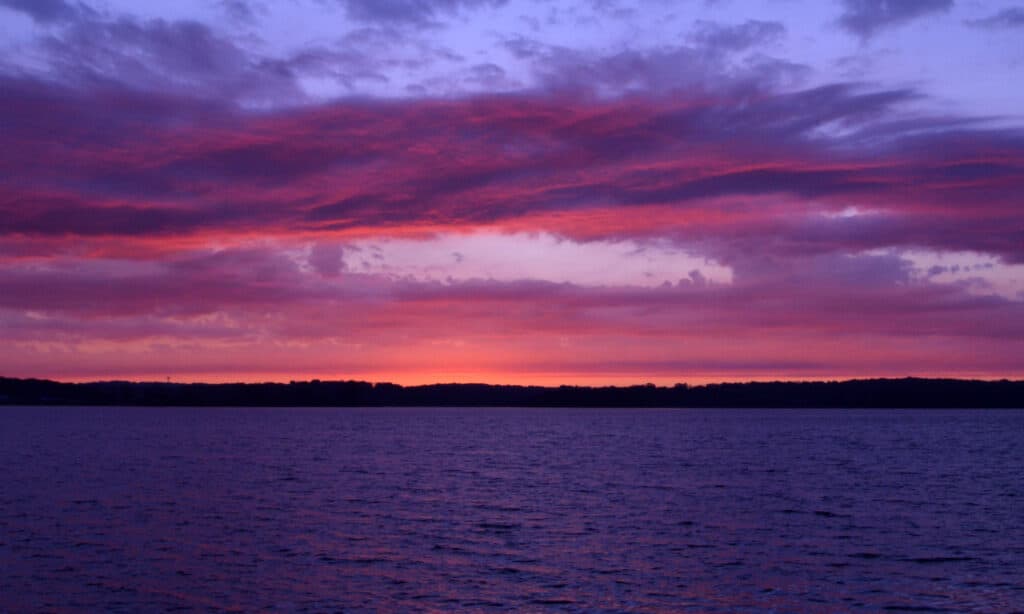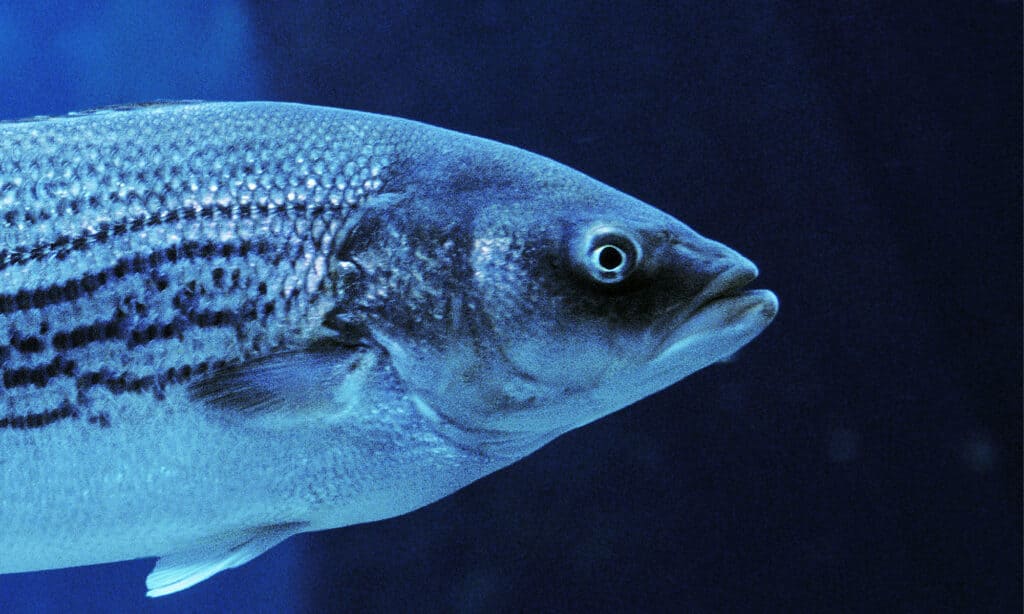
Without a doubt, Nashville is one of the most famous cities in the United States. Besides being the capital of country music, the city has a thriving nightlife, a low cost of living, and plenty of opportunities for adventurous outdoor activities. One of the many activities outdoor enthusiasts in Nashville can partake in is checking out J. Percy Priest Lake — the deepest lake in Nashville, Tennessee.
Located about 10 miles east of downtown Nashville, J. Percy Priest Lake is one of Nashville’s most popular lakes and a top tourist destination. The artificial reservoir draws millions of tourists who visit to partake in a variety of outdoor activities in the water and the area around it.
What Is the Deepest Lake in Nashville?

Percy Priest Lake covers areas of Davidson, Wilson, and Rutherford Counties in Tennessee.
©David Newbold/Shutterstock.com
The deepest lake in Nashville is the James Percy Priest Lake, which is located in north central Tennessee. Also commonly referred to as the Percy Priest Reservoir, this artificial lake was created by J. Percy Priest Dam, built over the Stones River.
The dam impounds a lake with a surface area of 14,200 acres and 213 miles of shoreline. The lake is popular among anglers since it is regarded as one of the best places to catch largemouth bass in all of Tennessee. Camping, swimming, picnicking, boating, canoeing, and hiking are other popular activities in this area. Both the lake and the dam that formed it were named after Congressman James Percy Priest.
Where is the Deepest Lake in Nashville on a Map?
The deepest lake in Nashville is located around 10 miles east of downtown Nashville, which is in the north-central portion of the state of Tennessee. It is about 2.5 hours drive west from Knoxville, Tennessee. Driving south from Louisville, Kentucky, it is just shy of a 3-hour drive.
How Deep Is the Deepest Lake in Nashville?

J. Percy Priest Lake reaches 100 feet deep at its deepest point, with an average of 29 feet deep throughout.
©iStock.com/FilzFotoz
J. Percy Priest Lake is 100 feet deep at its deepest point. This point of the lake is about ½ mile upstream of the J. Percy Priest Dam. The average depth of this lake is about 29 feet.
In addition to being the deepest lake in Nashville, Percy Priest Lake is also one of the largest lakes in the city. It covers three counties in and around Nashville: Davidson, Wilson, and Rutherford Counties. The lake itself has a total area of 14,200 acres. It is surrounded by 18,854 acres of public lands, with 10,000 acres of this dedicated to wildlife management.
History of the Deepest Lake in Nashville
In 1946, the U.S. Congress approved the “Stewart’s Ferry Reservoir” project, later known as the “Percy Priest Dam.” However, no building funds were appropriated by Congress after the authorization.
The name was officially changed on July 2, 1958, when Congress passed legislation in honor of Congressman Perry Priest. Businessman Edward W. Carmack and Cumberland River Development Association members submitted the petition to Congress to have the name of the dam changed in honor of Rep. James Percy Priest. Percy Priest was a teacher and high school coach. He also worked as a reporter and editor for The Nashville Tennessean (known today as The Tennessean) before he was elected to Congress. Before his death in 1956, he served as the representative for Nashville and Davidson County.
Funding for the project finally came in 1963 after years of planning and research. The U.S. Army Corps of Engineers worked on the project and completed it in 1967. During the construction, the entire town of Old Jefferson, which was in the area, was completely flooded and had to be relocated. On June 29, 1968, President Lyndon B. Johnson formally dedicated the dam.
Fishing at J. Percy Priest Lake

Many fish call Percy Priest home, including the striped bass.
©iStock.com/slowmotiongli
Anglers of all ages and skill levels flock to Percy Priest Lake throughout the year to fish. Whether you prefer fishing from a boat or the bank, you’ll find plenty of options throughout the lake and its surrounding areas. For those who prefer fishing from the banks, there are two enhanced fishing areas open for public use; the Stewart Creek bank fishing site located in Smyrna and the Vivrette Creek bank fishing site located south of Old Hickory Lake.
During the warmer months, the lake hosts numerous fishing events. Most anglers need to first get a valid fishing license from the State of Tennessee to fish in the waters of Percy Priest Lake.
The County Clerk’s office, marinas, and a wide variety of local businesses sell fishing licenses. Some of the most common fish species available at the lake are sunfish, striped bass, largemouth bass, Cherokee bass, white bass, catfish, crappie, bluegill, and trout.
Wildlife at J. Percy Priest Lake

Red-breasted mergansers are one of the ducks visitors may see at J. Percy Priest Lake.
©Brian E Kushner/Shutterstock.com
As part of the J. Percy Priest Lake Project, the United States Army Corps of Engineers manages 19,462 acres of land. Most of this area (up to 10,000 acres) is a public hunting and wildlife-watching preserve.
The lake area is home to various wildlife, including deer, rabbits, squirrels, waterfowl, gulls, red-breasted mergansers, northern pintails, pied-billed grebes, buffleheads, and more.
Recreational Activities at the Deepest Lake in Nashville
J. Percy Priest Lake receives millions of visitors annually who visit to participate in various recreational activities. You can go scuba diving in the lake. However, divers must fly a “diver down” flag above the diving area, which will inform boaters to stay a safe distance away.
Swimming is permitted in most parts of Percy Priest Lake. But swimmers are not allowed in certain places, such as around launching ramps, mooring points, public docks, and marinas that have signs prohibiting swimming. Areas, where swimming is allowed, are often boat-free for the safety of swimmers.
Percy Priest Lake is one of the most popular boating destinations in Nashville. Millions of visitors come to the lake just for boating. Boaters at J. Percy Priest Lake engage in a variety of activities on the 14,200-acre water surface. Boaters can easily gain access to the lake and its amenities at any of the lake’s five commercial marinas, which are dispersed across the body of water, or at any of the several Corps of Engineers access sites.
The number of boaters who visit J. Percy Priest Lake has increased over the past few years. As a result, the Corps of Engineers strongly recommends that visitors become familiar with the rules and basic boating regulations. They’re also to wear life jackets at all times, be cautious, and refrain from taking alcohol. Several water sports and leisure clubs, including the Tennessee Boat Club, Percy Priest Yacht Club, Vanderbilt Sailing Club, Vanderbilt Rowing Club, and the Nashville Rowing Club, are functioning in the lake area.
The Campgrounds at the Lake

Seven Points is a popular campground at Percy Priest Lake.
©Mavo Media 360/Shutterstock.com
Three campgrounds and 11 day-use picnic spots are available in the area surrounding J. Percy Lake. These facilities are cared for by the lake’s Natural Resource Management Office. Some of these campgrounds include the Anderson Road Campground, Poole Knobs Campground, and Seven Points Campground.
Conclusion
Percy Priest Lake is the perfect spot for outdoor lovers in Nashville. You can spend some time on the lake with a rented boat or simply explore the parks and campgrounds surrounding the lake. There’s ample space to enjoy the outdoors or engage in activities you love.
The photo featured at the top of this post is © David Newbold/Shutterstock.com
Sources
- All About Fishing, Available here: https://www.aa-fishing.com/tn/tn-fishing-lake-percy-priest.html#lakesspecies
- PercyPriestLake.com, Available here: http://www.percy-priest-lake.com/wildlife-management-area/
- Percy Priest Lake Visitors Guide, Available here: http://www.percypriestlake.org/percy-priest-lake-fishing.html
- Wikipedia, Available here: https://en.wikipedia.org/wiki/Percy_Priest_Lake
Thank you for reading! Have some feedback for us? Contact the AZ Animals editorial team.






